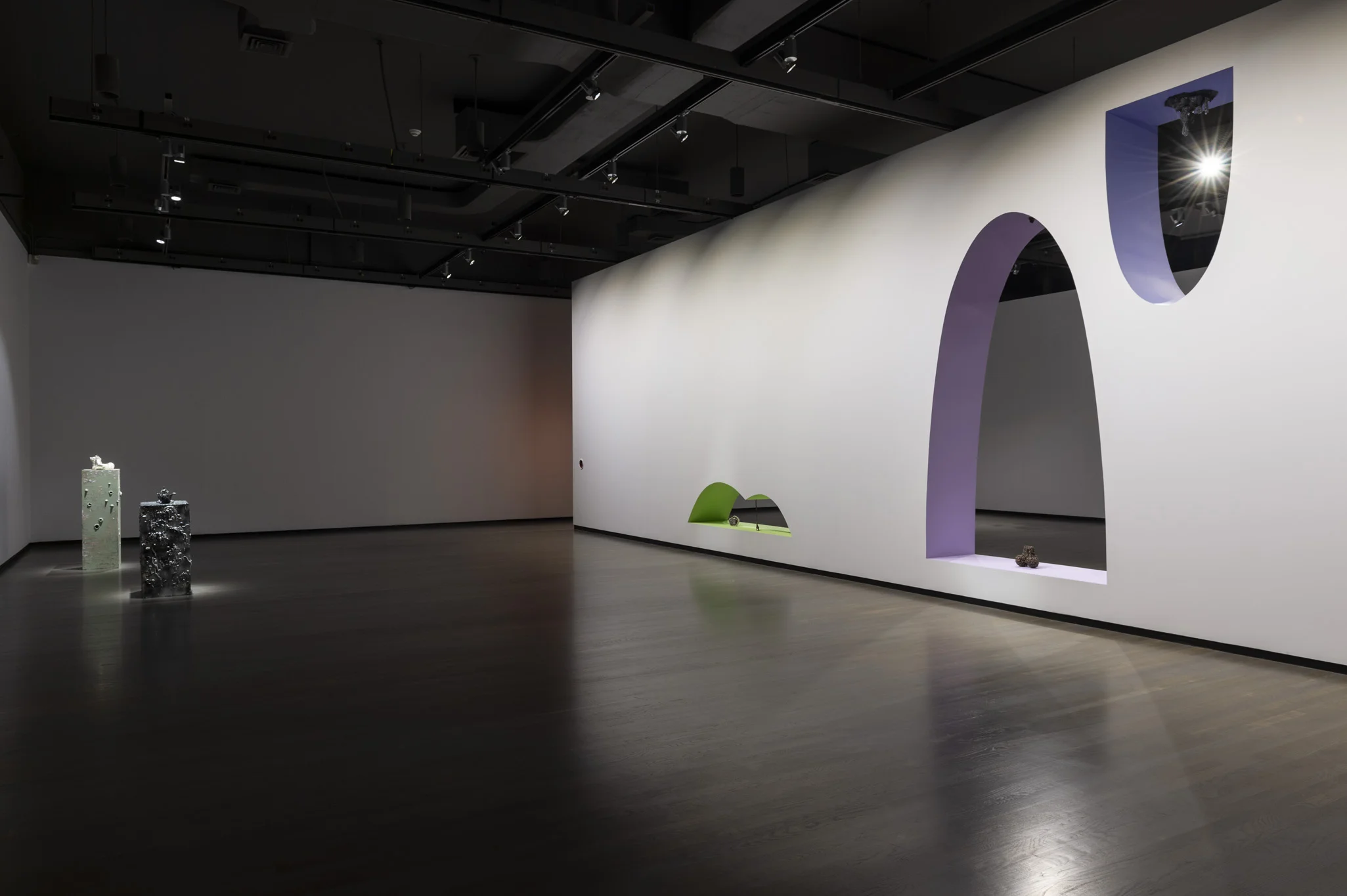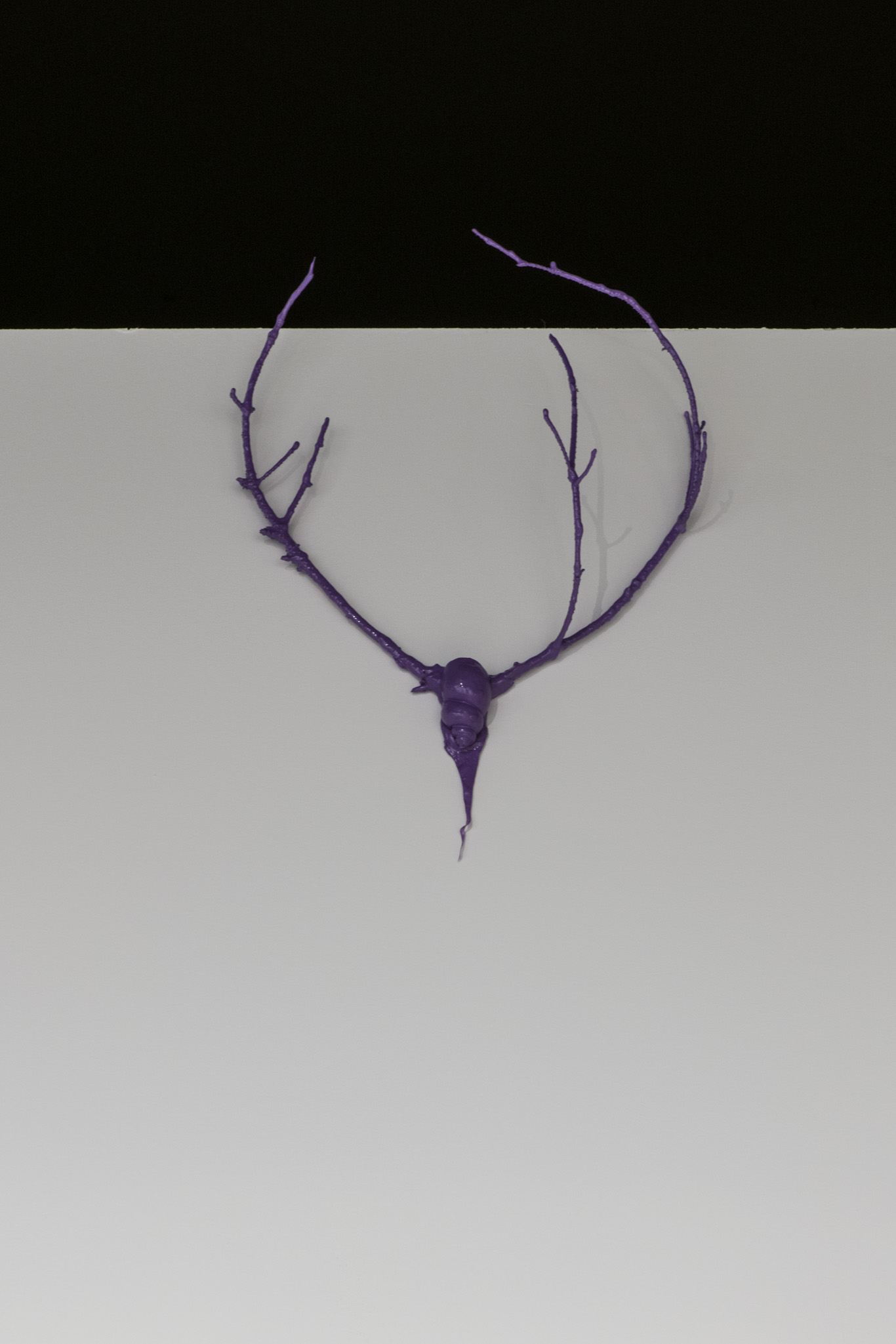
The Cave
THE CAVE
Young Joon Kwak
with Marvin Astorga, Shawna Dempsey and Lorri Millan, Adrian Stimson and Kim Ye
September 29 - December 14, 2018
The Banff Springs Snail is an endangered species found exclusively in the thermal pools of Banff’s Sulphur Mountain. Like many similar species, the snail has the capacity to self-reproduce, displaying both ‘male’ and ‘female’ sex organs. Most numerous within Banff’s Cave and Basin, it has a shell unlike many others; for rather than spiralling to the right, it curls to the left. Around the size of a small fingernail, it often goes unseen and is subject to strict regulations with human interaction. The Banff Springs Snail is an important feature within Young Joon Kwak’s THE CAVE, marking it as a space for contemplating the radical potential of marginalized bodies.
This exhibition, which is the Los Angeles-based artist’s first in Canada, builds on pre-existing work which counters the aesthetic of the “man cave” through a queered reading of the masculinist tendencies within these domestic spaces, as well as within social concepts of nature and outdoor culture. Unique to this exhibition is Kwak’s response to Banff National Park and the legacy of artistic practices which have engaged with the present and historical complexities of the region.
A new series of bronze sculptural works make reference to these local snails and are displayed in a fountain repurposed from a mirrored security dome, alluding to the surveillance of non-normative bodies within the everyday. Stalactites are evoked through works that drip in resin, while others transform familiar geometry and architecture into beings with orifice-like holes. Kwak’s sculptural work resonates with current discourses on queer abstraction, which writer Joseph Henry argues opens “new strategies for the imaging of non-binary genders.”1 These objects are also imbued with the parody of a queered camp aesthetic; a productive tension, where a visual withholding and the excess of slapstick are alternately wielded as political tools.2
In a spirit of homage, the exhibition also includes works by artists which similarly employ Banff as a touristic backdrop or film set. Like Kwak, these artists interrogate the region’s history through strategies of public performance, camp aesthetics, and elements of drag.3 In Shawna Dempsey and Lorri Millan’s iconic Lesbian National Parks and Services: A Force of Nature (2002), Banff becomes a stage to perform the intersections between heteronormative understandings of gender, the natural world, and the ways in which these conceptions inform Canadian national identity. Adrian Stimson’s work, Buffalo Boy’s Why Not? (2009), follows his performative character, Buffalo Boy, as he explores the streets of Banff in an acerbic but playful reflection on the town’s colonial history. Stimson’s experience as a person of Blackfoot descent makes the land visible as the traditional territory of Indigenous peoples.
The exhibition also includes a new collaborative video work by Kwak and Los Angeles-based artist Kim Ye that presents a fragmented storyline of a fictional family holiday. Drawing attention to the constructions of gender in an intentionally exaggerated performance of femininity, Ye plays a “mommy” figure to Kwak, the “baby,” and aims to mentor the youth in the difficult process of learning to “be a woman.” This performative reflection on the process of gender transition experienced by many individuals who identify as trans is interspersed with other vignettes. Taking inspiration from a selection of photographs of Marilyn Monroe shot while the celebrity was in Banff filming the 1954 film, River of No Return, the work satirizes idealized expressions of femininity connected with the townsite’s history. A nod to their own positions as Angelenos, who, like Monroe, experienced Banff as tourists, Kwak and Ye’s video, The Maternal River of No Return (2018), also critically reflects on the stereotypes and misrecognitions of identity in relation to touristic populations in the town of Banff.
1. Joseph Henry, “Queering Queer Abstraction,” The Brooklyn Rail, October 5, 2017.
2. This reading is aligned with curator, writer, and translator, Ana Iwataki’s interpretation of Kwak’s work in relation to the exhibition Hermy (2017).
3. Kathryn Walter, “Introduction: The Set, The Situation, The Cast of Characters” in Private Investigators: Undercover in Public Space, ed. Kathryn Walter and Kyo Maclear (The Banff Centre Press, 1999), 1-8.
All photos by: Jessica Wittman


The Cave (installation view)


Views (installation view)
from left to right: View “From the Bottom,” View “Negating In-Between,” View “Upper.”

Aggregate Snail Vaginis
2018
Bronze
20 cm x 16 cm x 11 cm

The Cave (installation view)
left to right:
Aggregate Snail Hangers, 2018, Bronze, 5 cm x 5 cm x 6 cm
Vaginis Canal Growths II, 2018, Cold-cast aluminum, soil, 30 cm x 25 cm x 20 cm

Snail Leg
2018, Bronze
10 cm x 33 cm x 4 cm


The Cave (installation view)

Plinth II (for Inverted Vaginis Masturbators V, VI, VII), 2017
Wood, paint
116.84 cm x 31.75 cm x 31.75 cm

Inverted Vaginis Masturbators V,VI, VII, 2018 Cast resin, silver leaf
Dimensions variable

Trans-Creation Relic, 2017
Cold-cast aluminum, resin, soil, rocks, wood, spray paint, latex paint 13.97 cm x 13.97 cm x 33.02 cm

Plinth III (for Trans-Creation Relic), 2017 Cold-cast aluminum, resin, rocks, spray paint, latex paint, wood 78.74 cm x 38.10 cm x 55.88 cm

The Cave (installation view)


Surveillance Vaginis Fountain, 2018 Convex acrylic security mirror, fiberglass, resin, wood, dirt, bronze snails
+
Exploded Heavenly Body, 2018 Cast-aluminum, welded aluminum rods, glass mirror tiles 45.72 cm x 45.72 cm





Mommy and Baby Girl’s Glamping Tent, 2018 Fabric, vinyl, streamers, Banff soil
160 cm x 89 cm x 178 cm

Slug Vaginis, 2018 Bronze
13 cm x 13 cm x 12 cm

Plinth IV (Baby Girl Deer), 2018 Wood, spray paint
57 cm x 48 cm 17.5 cm
+
Beercan Vaginis, 2018 Cold cast resin, plaster
8 cm x 12 cm x 7 cm



Young Joon Kwak & Kim Ye
Maternal River of No Return, 2018, Three-channel film installation, 13 min. (variable loop).


Young Joon Kwak and Kim Ye, Maternal River of No Return (Film Poster), 2018 Edition of 3, 2 artist proofs, 75 cm x 101 cm x 2.5 cm



























